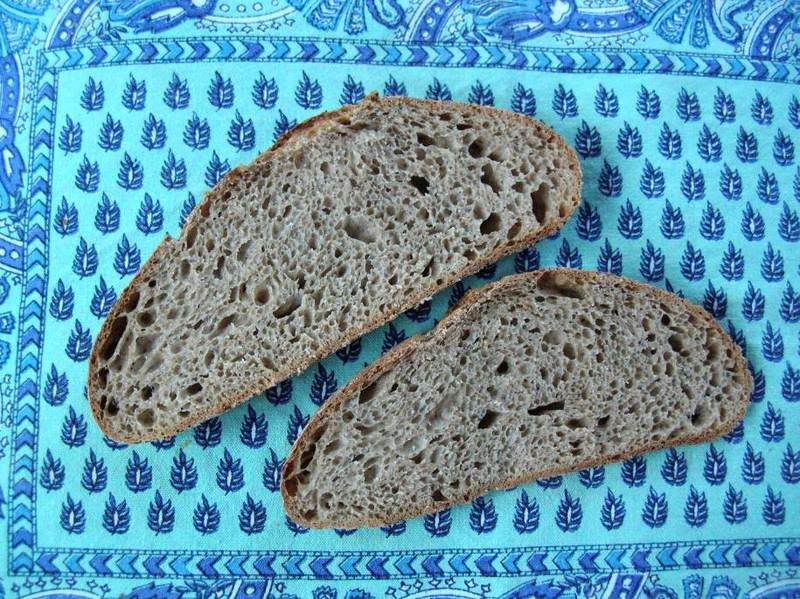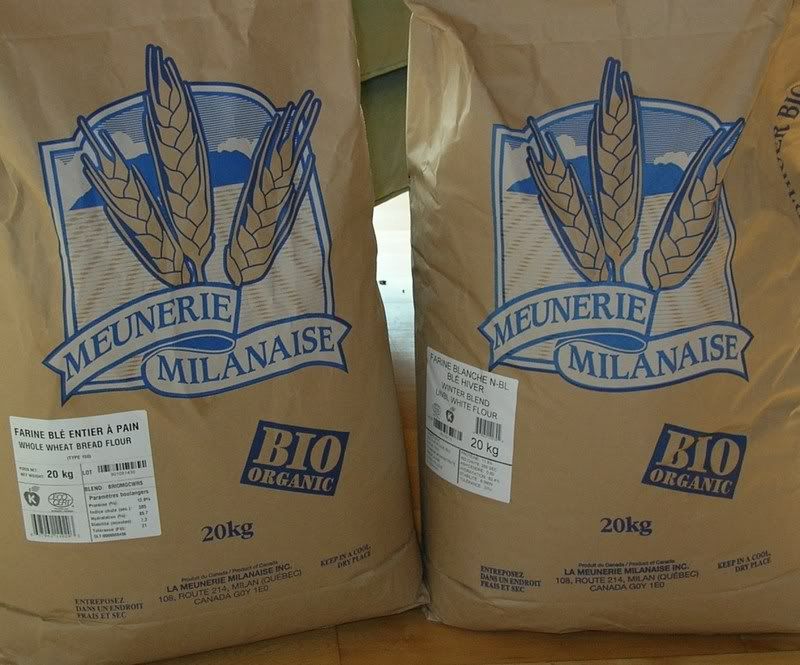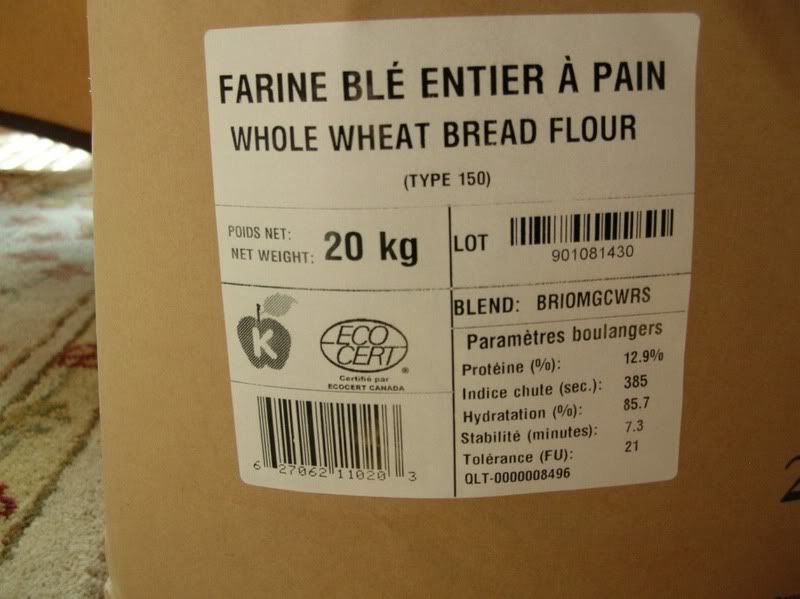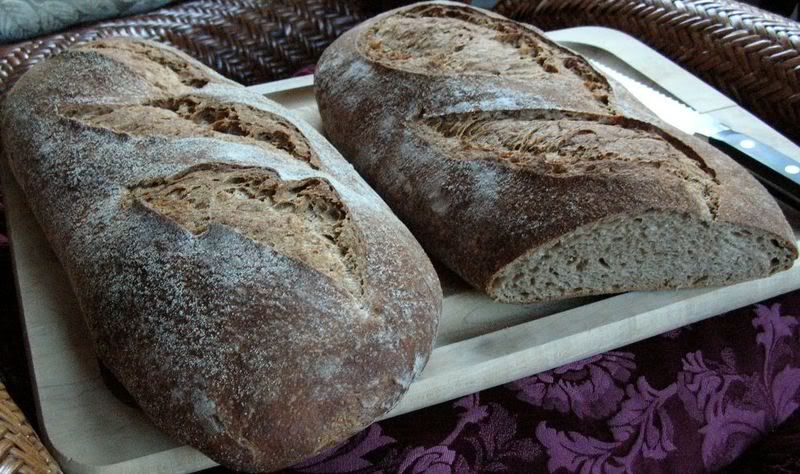
90% Milanaise Whole Wheat Sourdough, long cool ferment
I decided to revive my dormant Carl Griffith's 1847 Oregon Trail starter last week, so I had a lot of nice ripe starter by the end of the week on hand that I wanted to use up. I used an excel spreadsheet I made up for Flo's 1-2-3 sourdough to use up any amount of excess ripe sourdough starter, except in this case, I needed to increase the hydration since I was using all whole wheat flour in the final dough, so it became 1-2.25-3 bread (78% hydration final dough). The reason I made this as 90% whole wheat is simply because the excess starter I had was made up of about 25% whole wheat and 75% AP, so even though the final dough is all whole wheat, there is about 10% AP in the overall formula due to the large amount of starter.
One other thing that I got away with that I don't usually do is that all the starter used in this formula was actually ripe the day before I made the dough, but I got busy and just put it in the frig, so it was not as strong as it could have been since it was past peak, but the bread still came out with great flavor and a nice soft open crumb, chewy dark golden crust, not at all dense.

This is also the first bread I've made with my new big bag of organic Meunerie Milanaise flour from Quebec, and I notice a distinct difference in taste compared to either the King Arthur WW or Bob's Red Mill WW that I usually use (it handled very differently as well, very extenisble and silky dough). The Milanaise flour had absolutely no bitter whole wheat aftertaste, it was sweet, I imagine this must be what freshly-ground whole wheat flour tastes like, and this bag was milled on January 8 I think (thanks to Tete au Levain's tip on how to determine the milling date on the bag I had).


After mixing the final dough with my dough whisk just long enough to get everything incorporated, I let it rest 30 minutes, then did about 2-3 minutes of folding in the bowl with dough scraper, rest another 30 min., then 2 stretch & folds 30 min. apart, then just left it in it's bucket to bulk ferment overnight in my 62F basement Thursday night. Friday morning before I left for work, I shaped the loaves and placed them in a couche in my 50F basement refrigerator until I got home from work, then baked them as soon as the oven was preheated. They came out flatter than I had hoped, but since it is a wet dough, and mostly whole wheat, that may be expecting too much. To me the most important thing was the open crumb and great taste these had, much better than the desem bread I attempted 2 years ago.

I am happy enough with this result and the taste that I plan to make this our weekly bread from now on, since I'd like to reduce the amount of white flour we are eating these days. The Oregon Trail starter is a very strong and fast riser, so I was hoping it would do well with whole grains, and I think it did. I will try this formula again with my home-made starter to see if it does as good a job rising this dough as "Carl" did. I also hope using a starter that is at peak (as opposed to older discarded starter past peak as used here) will improve the volume.


Comments
Lovely loaves, Sounds like you have a wonderful flour! ...I love whole grain breads. Did you use any honey or molasses?
Sylvia
Thanks Sylvia - no this was a lean sourdough, just flour, water, salt, and starter. The final dough formula was:
Overall hydration including starter was 78.5%
Great looking bread, Mountaindog. Where did you find the Milanaise flour?
Wish I could find a whole wheat flour that was palatable to me.
Thanks Lindy - I am fortunate to be able to buy flour in bulk occasionally from Dan Leader's Bread Alone bakery, which is just down the road from me. He uses mostly organic flours, and mostly Canadian flours I've noticed. I got a 44 lb (20 kg) bag each of org. white flour and org. stoneground WW and paid $44 for each ($1/lb), which is an excellent price per lb for organic flour around here (even regular King Arthur AP flour is not much cheaper at about $0.78/lb in my local supermarkets).
Meunerie Milanaise is a mill in Quebec. Hamelman menions it in a sidebar in Bread on the chapter on wheat. You are in Michigan, correct? I'm not sure how close you are to the Canadian border, but perhaps there are some distributors not too far from you who may carry this? You could try contacting them and asking. On the other hand, have you ever tried milling your own whole wheat flour with something like a Nutrimill? I've not tried it myself, but my sister in VT swears by it, and I can vouch for how delicious her pancakes and rolls are when made from it. Next time I see her I need to get some fresh ground flour from her to try in my own bread recipe. I hear that freshly-ground WW also tastes much sweeter than what you can typically buy in the supermarket - if it tastes anywhere as good as the Milanaise WW, it would be worth milling it to me.
Mountaindog, you're inspiring me to dust off my desem and start playing with it again :-)
Thanks Debra! I think I may have mentioned to you on a past thread that I was nursing along another desem - er - I was until about 2 weeks ago, and I gave up - again - after I got another set of bricks as a result. That's when I decided to wake up Carl and see how he would do with whole wheat flour. My homemade starter that I used to make last month's desem culture seems to not like 2 things: being maintained in a stiff doughball, and being too cool - which means it didn't like life as a desem starter at all I guess :-)
I'd love to see any experiments you do with desem, though, so please keep us posted!
It took mine a week or so to really come around after I converted my white sourdough to a (very) firm, ww desem. I kept it about 55 degrees and fed it as soon as it was ripe each time, and it just perked up one day and started rising much faster.
I get better results with less "pre-fermented flour" than what Laurel Robertson uses in her formula, and much better crumb with loaf shapes that have a bigger footprint to volume ratio and lower height so that the center of the dough is closer to the stone (i.e., baguettes). 90-degree proofing doesn't work for me, and I really have to watch that I don't ferment too long, but I haven't really mastered the different stages yet. Once, my loaves opened up to a nice airy crumb with big shiny holes, but I think the desem gods were just stringing me along with "intermittent reinforcement" as David calls it :-) I have yet to reproduce this. But, the pictures are proof it is possible...
That is probably the best looking WW, never mind just desem, crumb I have ever seen! Those large holes look like a nice cat track right in the center, in fact! Whatever you did that time, the gluten was perfectly developed with those shiny cell walls. I agree that usually any loaf of mine comes out better when there is greater surface area, like batards vs boules - less mass to rise I guess for the cell structure size.
I will try using less preferment next time I make this as you say. What about mixing? I hardly mixed this, just folded in the bowl and stretch & fold. I know other WW recipes say to knead like 20 min. in a stand mixer...not sure if that actually helps with a long ferment recipe anyhow.
I agree, baking is exactly as David described with "intermittent reinforcement"! Thanks for posting this great shot...
Ha! I never noticed the paw print before :-) I really would like to master desem, but I have to admit that I don't like the taste as much as room temp naturally fermented ww breads. Either way, I need to get back to the 100% whole wheat breads again.
I started reducing my pre-fermented flour on a tip from Thom Leonard. If I remember right, he was using about 15-18%. Without looking it up, I believe Laurel Robertson's is 33%. It's been a long time, but I think I got the best results down around 10%. And I keep my ww starters very firm (about 60% hydration). I calculate yours at 14% pre-fermented flour, so you're right there in the zone. The idea is to use the smallest amount that gets the job done.
Thom recommended 90-100% hydration for the final dough, but I found it difficult to work with, and I don't think my stone is heavy enough to "blow up" such wet loaves properly. Maybe if I had a 30-pound hearthkit, but I just don't have a place to store it. The bread in the photo was 85%---my preferred hydration level for whole wheat. My stone weighs 11 pounds. It seems to me that weight would make a difference.
It didn't seem to matter how long I mixed, I could never get a very springy dough at the start. It was smooth, and the gluten seemed developed enough, but the ball of dough always slumps in the bowl at first. After two or three stretch-and-folds over a 3 to 4-hour bulk ferment, the dough transforms and sits up nicely, and is easy to shape. I'm not sure that long fermentation really suits this kind of bread. I remember another desem baker saying 6 hours total (from mix to bake). My experiences were about the same with both desem and ww sourdough. The starter needs to be in really good shape going into it though.
After having said all that, I am by no means an expert on this ;-)
Debra - thanks for the WW tips from both you and Thom Leaonard (his Country French bread recipe from Glezer is still my all time favorite that I make nearly every week).
I am taking notes from your last post and I will try a few things differently this weekend for 100% WW:
I'll try this out on Saturday when I am home to do the short warm ferments and see how it goes. Thanks again, and keep me posted on your whole wheat tweaking as well. If I can get a WW loaf that we like as much as my usual mixed flour loaves, it will be much better for our blood sugar levels to have this as our daily bread.
MD, this is a nice exchange between you and Debra. Thanks for mentioning it in Sylvia's thread. I'm still searching for the perfect desem. Most of the ww breads I have made I haven't cared for the flavor much. Maybe it's time to try again now that my starter is up to speed and tasty.
Eric
Thanks Eric - have you ever tried freshly ground WW? My guess is it may be similarly sweet to this flour and change your mind about the flavor, but perhaps you've already tried that and still not crazy about it?
I thought a lot about this too, as I really love my mixed flour miches. I notice even if the dough is less than half AP flour, it tastes great to me, and not like I'm sacrificing flavor to get more whole grains. So if I really don't end up making a satifying 100% WW SD, at least a 60-70% WW one will be pretty great too and still healthier than a mostly white one. In fact I personally do not care much for bread made with more than 80% white flour, so I'm not a huge baguette fan, unless made with more WW.
And just to clarify to the desem purists, I'm not making desem, I gave up on that, I'm just trying to make a good tasting and textured WW SD using my 100% hydration starter (although I will do a firm levain build for the next trial, but I realize it is not a desem culture being used).
Hi Mountaindog & Debbie. I'm also trying to tweak an WW SD recipe. Currently it is at about 75% hydration. Do you think a more open crumb might be achieved if I bump the hydration level up to 80%?
I was also looking over the notes in BBA on WW SD and noticed a recommendation that loaves be kept to about 8 ounces owing to the limitations of home ovens, i.e., 8 ounce loaves would have a better chance at oven spring and crusty crusts. Any thoughts on this?
--Pamela
Hi Pamela - I would definitely try upping the hydration, since WW absorbs much more water than AP. Mine was over 78% but as Debra suggests, 85% is what I'll try next. I don't recall the BBA section on WW SD, but smaller loaves will give you a greater crust to crumb ratio which seems to help open up the crumb too. 8 oz seems a bit small (8 oz of uncooked dough, correct?), I think the shape is more important. If you make a batard shape that is fairly long and narrow, it will rise better, it can be bigger than 8 oz. My batards are usually about 2.5 lbs of dough. Certainly a baguette shape would rise well too.
If you bump up the hydration, be sure to give it enough folds to strenghthen it up, and use a starter at it's peak, as Debra suggests. Show us some pics when you try it!
OK I'll up the hydration and bake as a batard. Eight ounces of dough does seem pretty small, so I'll try about 16 ounces and increase the crust to crumb. I'll let you know what happens. (I'm using a peak starter.)
--Pamela
Speaking of WW and sourdough: Has anyone studied Katina's thesis on sourdough in wheat breads, or experimented with the suggested bran sourdough?
Hi Hans! Leave it to you to point us to a great academic article. I know what I will be curling up with to read tonight, thanks! I've never heard of bran sourdough, and I can't wait to find out what it is, based on the abstract's description of what it can do.
I must go and read this now...